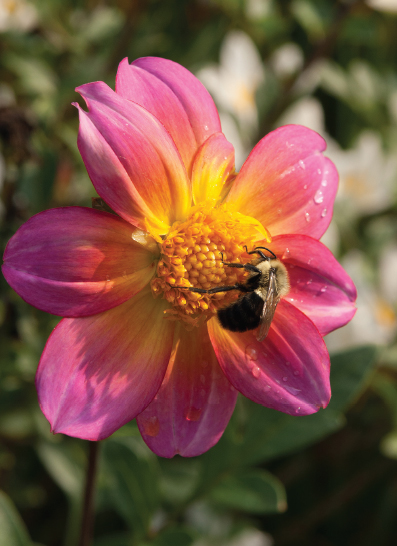Want to attract more bees into your garden? Here is a list of tips and plant suggestions that will help make your growing spaces more bee-coming to these friendly flying insects.
Go wild. Naturally, bees favor native plants, and there are many from the wild that can do double duty as great visual additions to cultivated garden beds. Including any indigenous eye-catcher such as foxglove, yarrow, liatris, goldenrod, ironweed, turtlehead, sunflowers, Joe-pye weed, penstemon, swamp milkweed, Echinacea, black-eyed Susans or gaillardia is a good way to enjoy a two-fer — beauty and the bees.
Reproduction reduction. As plant breeders continue to create bigger, bolder, brighter introductions, many of the new-fangled cultivars lose other traits, including the ability to reproduce, resulting in flowers with little or no pollen for bees. If you are not sure the selections you are thinking about buying are packing useful pollen, just ask the folks at your local friendly garden shop, or simply go with two sure bets — native plants and heirloom varieties.
Landing pads. True to the old saying, bees are always busy, so they would rather not spend too much time maneuvering in and through a flower to get at the pollen-laden center. That is why they buzz at the sight of single flowers with flat faces. Dahlias, zinnias, Queen Anne’s lace, daisies, cosmos, marigolds, clematis and asters all fit the bees’ bill for user-friendly, flat surface blooms with easy-to-reach pollen.
Fragrant fly-in. Like people, bees are attracted to sweet smells, so think about adding perfumed plantings that are any combination of forget-me-nots, heliotrope, nasturtium, phlox, four o’clocks, soapwort, nicotiana or honeysuckle. Herbs can be helpers as well, especially pleasantly scented ones such as hyssop, basil, rosemary, sage, catnip, lavender, borage, chamomile, thyme, marjoram and bee balm.
Color their world. Bees are also drawn visually to flowers. It seems yellow is their favorite color, followed by blue, purple and white. Interestingly, bees are color blind when it comes to red — it looks like a shadowy black to them that fades into the foliage. However, there are some plants with red blooms that have ultraviolet coloring mixed in, making them appear to be an agreeable blue to bees. These include pansies, corn poppy and bee balm.
Critical mass. Whether you go with colors or scents to attract bees, remember, one or two plants won’t turn too many of these fuzzy flyers around, so put out a more obvious “Welcome” sign in the form of mass plantings that flow in broad sweeps through the garden.
L.A. Jackson is the former editor of Carolina Gardener Magazine. Want to ask L.A. a question about your garden? Contact him by email at lajackson1@gmail.com.
To Do in the Garden
March
- After their flowers fade, forsythias can be pruned. To maintain their natural flowing shapes, concentrate on cutting back only older, larger branches that overreach their bounds.
- Don’t be so quick to heavily mulch beds containing summer annuals. Allow the sun to warm the garden soil until at least mid- to late April to get heat-loving seeds and young plants off to a faster start.
- Before grass and other groundcovers begin to grow, survey stepping stones in the garden and reposition any that are not level or have become loose.
- Also, while the landscape is still at rest, walk about the yard and clean up any sticks or stones that could become missiles when lawn mowing begins.
April
- If you like the sight of flitting hummingbirds, keep in mind that they are attracted to such plants as crabapple, redbud, honeysuckle, lilac, bee balm, salvia, azalea, weigela and coralberry.
- Two secrets for a full-flowering clematis: 1) Make sure it gets plenty of sun (five to six hours a day); and 2) keep the roots cool with a 3- to 4-inch thick covering of organic mulch.
- Dahlias can be planted as soon as the threat of frost has passed. Include a support stake in each planting hole to avoid damaging the root system or tuber later.
- The middle to end of April is early veggie planting time, so get a jump on the growing season by adding such heat-loving edibles as tomatoes, peppers, cucumbers, green beans and squash to the garden.
 Timely Tip
Timely Tip
If you are thinking about growing such popular plants as lettuce, snapdragons, ageratums, balloon flowers, petunias, coleus, osteospermums, columbines, nicotiana and impatiens from seed outside in the garden this year, let the sun help for better germination.
These seeds are a bit odd because they need light to properly sprout. The best planting technique is to simply scatter the seeds over a prepared bed in a sunny location and then lightly press them into the soil surface with your hand, keeping the ground evenly moist while waiting for sprouts to appear.
Resist tucking these light-loving seeds any deeper into the dirt; such “over-planting” will easily become a burial.







